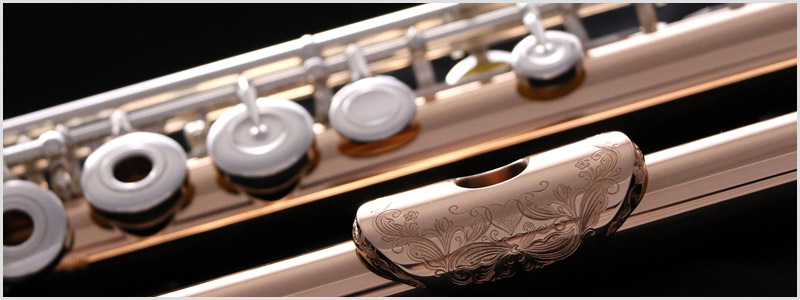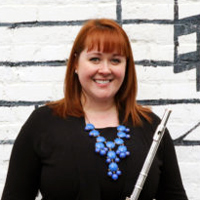
Finding Your Flute by Dr. Rachel E. Haug Root
Near the end of middle school, my flute teacher told my parents it was time to consider buying a new flute. She gave them a list of suggested brands and specifications, they consulted some catalogs, and two weeks later, my flute arrived. Although this method seemed practical nearly 15 years ago, there are far more options to consider now. With a wealth of brands at our disposal, each offering its own unique qualities, how do we find our flute?
Although the options seem daunting at first glance, here are a few criteria to help narrow the search.
Open holes:
With very few exceptions, intermediate flutes will have French keys (open tone-holes). They create a larger, more robust sound and also add resonance and greater projection to the instrument. Open holes can take some adjustment, so most open-hole flutes come with plugs for the keys, allowing players to more easily transition. Once the player adjusts, the plugs can be removed.
Higher silver content:
Our very first flutes are constructed primarily of nickel. Although durable, they tend toward very bright, sometimes piercing timbres. By incorporating more sterling silver into the instrument, we obtain greater richness and depth of sound. At the intermediate level, begin with a headjoint that is sterling silver. From there, move on to body tubing and, eventually, the mechanism.
Inline vs. Offset G:
There are two options when choosing the basic set-up for our flute: inline or offset G. Although inline G was once considered the standard for intermediate and professional instruments, more and more flutists are now choosing the offset option because of its ergonomic advantages.
Extra keys:
Inherent in their design, intermediate and professional flutes come with a B footjoint, extending our range from middle C to the note just below. Because it adds length to the flute’s tubing, this key assists in creating greater depth of sound. Additionally, many flutes include options for split E mechanism, C-sharp trill, and D-sharp roller. Flutists should consult a teacher or expert about the advantages and disadvantages of these additions.
Try instruments:
Finding a flute is a very personal decision. Essentially, we are finding our voice. When at all possible, visit shops that allow instrument trials to discern which models and options work well. If possible, find a location with a qualified expert who will give constructive feedback and can explain the differences from one model to the next. Take several flutes home on trial and play them in rehearsals and lessons to obtain additional feedback.
With these suggestions in mind, the process becomes relatively easy. Arriving at an appointment with this knowledge will make the entire process much more enjoyable, and you will be able to find your flute.
Contact your Schmitt Music store, or get in touch with the specialists at The Flute Gallery to learn more, or to set up your flute selection appointment. You can also visit Schmitt Music’s online Flute Gallery store – SHOP FLUTES now!
 Dr. Rachel E. Haug Root is a freelance flutist, orchestral musician, and private instructor in the Minneapolis area. In addition to her responsibilities as The Flute Gallery Manager, she maintains a private flute studio in the Twin Cities, and her students are frequently accepted to summer festivals and honors ensembles. Rachel also holds the position of Piccolo with the Mankato Symphony Orchestra and has performed with the La Crosse Symphony, Linden Hills Chamber Orchestra, John Philip Sousa First Memorial Band, Central Ohio Symphony, and the McConnell Arts Center Chamber Orchestra.
Dr. Rachel E. Haug Root is a freelance flutist, orchestral musician, and private instructor in the Minneapolis area. In addition to her responsibilities as The Flute Gallery Manager, she maintains a private flute studio in the Twin Cities, and her students are frequently accepted to summer festivals and honors ensembles. Rachel also holds the position of Piccolo with the Mankato Symphony Orchestra and has performed with the La Crosse Symphony, Linden Hills Chamber Orchestra, John Philip Sousa First Memorial Band, Central Ohio Symphony, and the McConnell Arts Center Chamber Orchestra.
Rachel earned her DMA and MM in flute performance from The Ohio State University, where she studied with Katherine Borst Jones, and BA from Luther College under the instruction of Dr. Carol Hester. Rachel’s research, An Introduction to Twentieth-Century Flute Music by Norwegian Composers: With Emphasis on Øistein Sommerfeldt and Publications by Norsk Musikforlag, seeks to broaden awareness of the available flute repertoire. During her time at Ohio State, Rachel served as principal flute in the Wind Symphony and Symphony Orchestra while also performing as a member of the Ohio State Fife and Drum Corps. Additionally, she assisted in planning the annual Central Ohio Flute Association Festival at Ohio State, serving as newsletter editor, exhibits coordinator, and president.
Rachel is the recipient of the OSU Graduate Achievement Award and past winner of the DMA concerto competition. She is featured on the Naxos recordings Network and Rest, and in the 2008 Emmy Award-winning production Christmas at Luther. She has toured with ensembles throughout the United States, Europe, and Japan.
